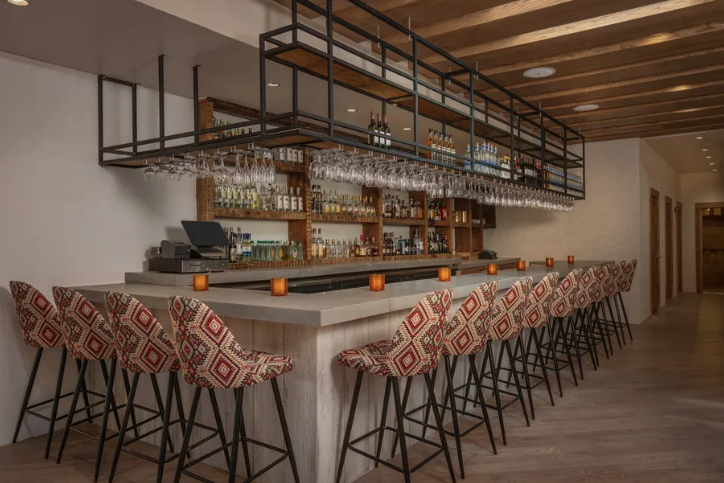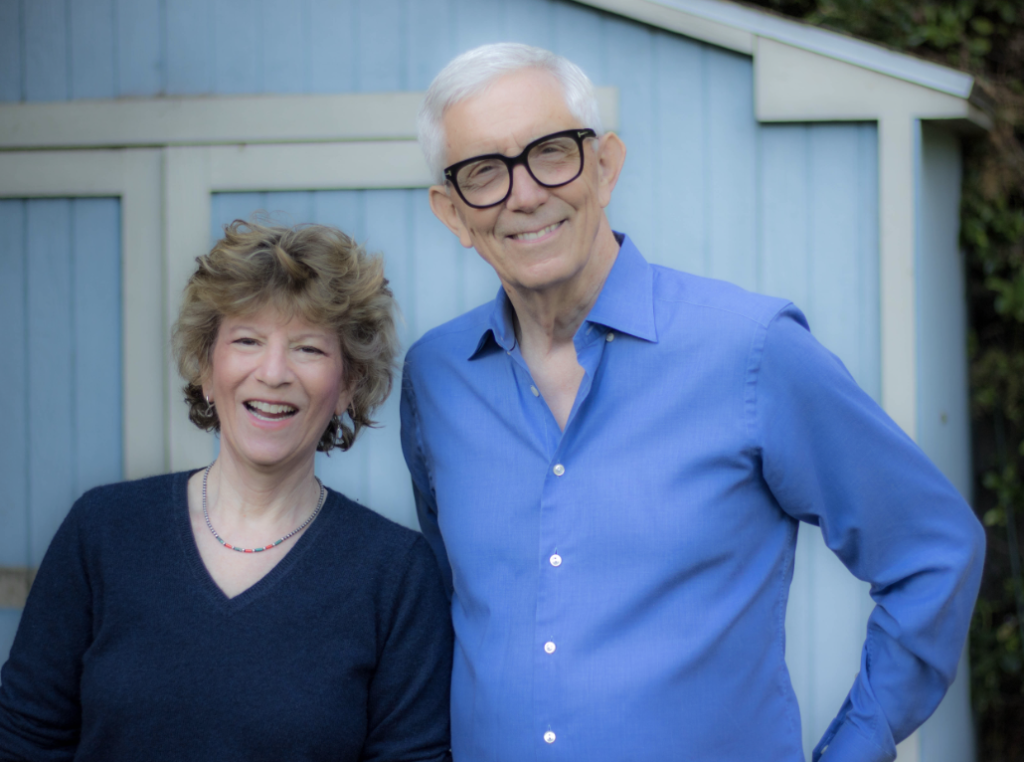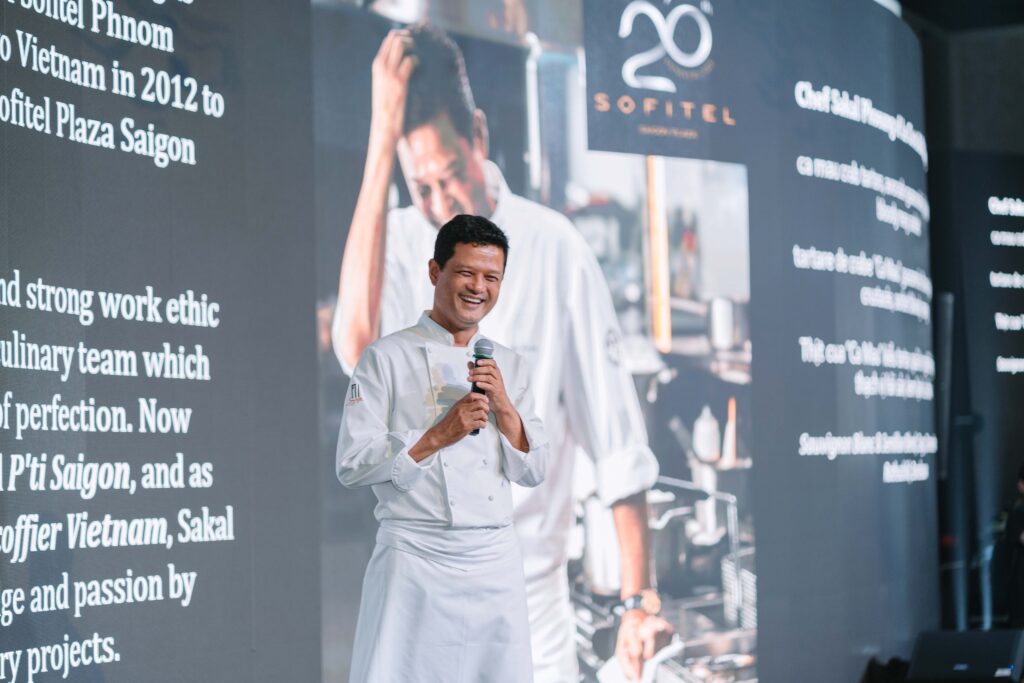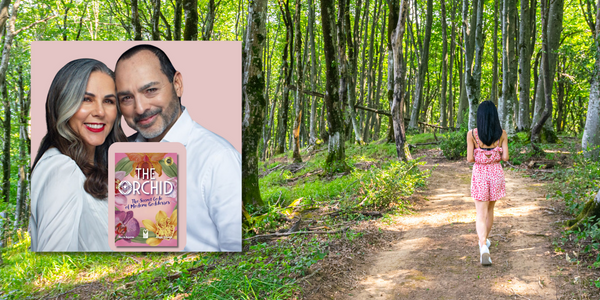Ambar Capitol Hill serves small plates with rustic Chic flair
Ambar on Capitol Hill is the seven-year-old birthplace of a Balkan and Mexican restaurant empire now sprinkled across the DMV.
Its mezze-focused flagship operation (523 8th Street SE). The 3,000-square-foot Balkan oasis is twice as large, with a new pastel-hued patio.
The rooftop welcomes guests 365 days a year with movable, teal slats that open up and close at the push of a button.
Its first-floor patio can fit dozens of diners across the two outdoor areas.
As you walk in, guests are surrounded by visually bold floor-to-ceiling stone walls.
Four separate dining areas create a vibe with their own names and themes:Chef’s Room, Rakia Bar, The Wine Cellar and Garden Room.

The “Rakia Bar” plays up Balkan’s famous fruit brandy.
Balkan spirts and wine are poured at all four bars on-site.
A second-floor wine cellar, lined with a 360-degree assortment of vintage bottles, plans to evolve into a bar that hosts educational tastings.
Ambar ran a series of virtual wine classes during the pandemic to help build up a following for the less-known wine region.
Ambar is mbest-known for its small plates menu: familiar spreads, salads, Serbian small plates, flatbreads, and lamb lasagna.
$25 per person at lunch and $35 per person at dinner with a two-hour time limit.
A takeout menu for two ($39) includes mains like wild mushroom risotto or beef short rib goulash.
YOU MIGHT ALSO LIKE
Bubbly East Coast Prosecco Tasting! Discover with Wine Expert Alan Tardi Wed June 26th at New York Wine Studio
DC Heads to NYC for Prosecco! Taste and Discover with Wine Expert Alan Tardi Wed June 26th at New York Wine Studio
Prosecco has gone from a little known mountain fizz to a vinous superhero, overtaking Champagne (and every other sparkling wine out there) and enjoyed by wine drinkers throughout the world, as the base of a cocktail or an everyday quaff.

But despite its huge popularity, most people don’t know much about it.
And there is much more to Prosecco than many people are aware.
”My objective is to
clarify the critical differences
between the original ancient Conegliano Valdobbiadene Prosecco and
the DOC Prosecco that was enacted in 2010.”
Alan Tardi
New York Wine Studio
Prosecco is produced only in Italy, in the Northern regions of Veneto and Friuli, and there are three official Prosecco appellations.

Prosecco DOC
One of them, Prosecco DOC, was created in 2010. It occupies a huge, mostly flat area encompassing almost two entire regions and accounts for most of the 700+ million bottles of Prosecco produced each year.
Conegliano Valdobbiadene Prosecco DOCG
Conegliano Valdobbiadene Prosecco DOCG is a tiny area in the foothills of the Dolomites consisting of 15 small municipalities in the province of Treviso. This is the ancient winegrowing area where Prosecco was born and made a miraculous comeback in the aftermath of World War II.

New York Wine Studio’s Alan Tardi
Besides its pedigree, there are numerous factors of the Conegliano Valdobbiadene enclave that distinguish it from any other winegrowing area in the world: complex and diverse topography, variety of soils, native grape varieties, distinct sub-areas, ancient history, and varied typology—bubbly, fizzy, and still; secondary fermentation in tank or in bottle, leaving sediment in the bottle (known as Ancestral Method) or removing it (Traditional Method).

In this class—which takes place right in the middle of National Prosecco DOC week—we will discuss the origin and evolution of Prosecco in the Conegliano Valdobbiadene area. We will also examine the two additional Prosecco appellations created in 2010.
But most of the time will be devoted to exploring and tasting Conegliano Valdobbiadene Prosecco through a lineup of 8 exceptional terroir-driven wines, in a variety of styles, that demonstrate the unique characteristics, complexity, and diversity of the original Prosecco.
Participants will also learn how to say “CONEGLIANO VALDOBBIADENE” like an Italian!

Alan Tardi has arranged a fantastic lineup of unusual and exceptional wines (half of them are coming directly from Italy) which demonstrate the various factors that characterize the complexity and uniqueness of Conegliano Valdobbiadene: Different production methods (“Tranquillo” i.e. still, Martinotti, Classico/Traditional, Ancestral); frizzante, spumante; single vineyards, Rive, native grape varieties; diverse, soils, terroirs and topographies.
List of Wines
- Prosecco Tranquillo DOCG “Il Canto Antico” — BORTOLOMIOL*
- Colli Trevigiani IGT Verdiso Frizzante Sui Lieviti — GREGOLETTO
- Progetto 5 Varietà Conegliano Valdobbiadene DOCG Brut — MARCHIORI*
- Conegliano Prosecco Superiore DOCG Rive di Ogliano Extra-Brut — BIANCAVIGNA
- Superiore di Cartizze Brut DOCG — RUGGERI*
- Superiore di Cartizze DOCG “Private” Rifermentato in Bottiglia 2014 — BISOL
- Conegliano Valdobbiadene Prosecco Superiore DOCG Rive di Carpesica “S.C. 1931” Metodo Classico — BELLENDA*
- Valdobbiadene Prosecco Superiore DOCG Asciutto, Rive di Colbertarldo, Vigneto Giardino — ADAMI
- Torchiato di Fregona Colli di Conegliano DOCG “Ciàcoe” 2016 — CA’ DI RAJO*
*Shipped directly from the winery in Italy
Find more information and buy tickets at New York Wine Studio or at the link below.
https://www.newyorkwinestudio.com/original-prosecco
Bob Dylan’s Bourbon Feud: Heaven’s Door Kentucky vs Tennessee
Bob Dylan’s Bourbon Feud: Heaven’s Door Kentucky vs Tennessee
Heaven’s Door Spirits, Bob Dylan’s highly awarded collection of super-premium American whiskeys, is turning up the heat on the age-old debate of which state, Tennessee or Kentucky, makes the best bourbon.
For as long as corn’s been cracked and stills have bubbled, Kentucky and Tennessee have been turning pristine limestone water and grains into a coveted amber elixir.
Heaven’s Door’s Great State Bourbon Debate rekindles the friendly feud
Heaven’s Door’s Great State Bourbon Debate rekindles the friendly feud between these two bourbon powerhouses, inviting whiskey lovers everywhere to put their palates to the test and voice their opinion.
Heaven’s Door sets itself apart as the first brand to offer both a Kentucky and Tennessee bourbon, giving fans a unique chance to compare.
The brand’s Kentucky Straight Bourbon, Ascension, and Tennessee Straight Bourbon, Revival, are made from high rye mash bills with grains largely sourced local to the distillery, and barreled at the same proof, yet yield vastly different taste profiles. Heaven’s Door invites you to level set, savor and decide which bourbon pleases your palate and wins your heart.
A Tale of Two Bourbons
Many folks mistakenly believe that bourbon can only be made in Kentucky, but the truth is, bourbon can be crafted anywhere in the U.S.
What makes an American whiskey a true bourbon is a special set of rules: it has to be made with at least 51% corn, distilled at a certain proof, and aged in new oak barrels.
Kentucky and Tennessee both have storied histories of producing excellent bourbon, with differences in water and climate producing distinct flavors.
Kentucky’s limestone water and Tennessee’s pure spring water are both famous for helping yeast thrive during fermentation.v
Differences in flavor profile come from the type and provenance of the grains used, the type of yeast used, water quality, the proof at distillation and the particular wood used to make oak barrel.
Even the location of the barrel warehouse, the circulation of air between the barrels being stored and where the barrels are within the warehouse (high up or near the bottom) all conspire to give impart flavor differences.
Heaven’s Door Kentucky Straight Bourbon, Ascension
Heaven’s Door Kentucky Straight Bourbon, Ascension, is a unique blend of two premium Kentucky straight bourbons aged for over five years and non-chill filtered, boasts warm and slightly sweeter notes of vanilla and baking spices. The limestone-filtered water of Kentucky, renowned for its purity, plays a key role in developing these rich flavors.
Heaven’s Door Tennessee Straight Bourbon, Revival
Heaven’s Door Tennessee Straight Bourbon, Revival, also aged for over five years and non-chill filtered, offers a drier profile with complex and sharp flavors. Unlike many Tennessee bourbons, Revival skips the “Lincoln County Process” – a charcoal filtering step – allowing the natural flavors of the local non-GMO grains to shine through, resulting in a lingering finish with hints of caramel, cinnamon, and nutmeg.
“We wanted to fan the flames of this old debate
between Kentucky and Tennessee bourbon
and showcase
our outstanding expressions of both styles.
We’re excited to hear what consumers think and how they experience these two classic bourbons.”
Alex Moore
Master Blender and COO
Heaven’s Door Spirit
Heaven’s Door marries art and craft in every bottle, drawing inspiration from Bob Dylan’s restless spirit to continually innovate. By sourcing non-GMO grains and honoring each state’s natural elements, the distinct character of each bourbon is evident in every sip.
Yo DC! Following your Heart and Need Media Attention? Reach to Publicity For Good, CEO Heather Holmes explains
Yo DC! Following your Heart and Need Media Attention? Reach to Publicity For Good, CEO Heather Holmes explains
Publicity for Good is a millennial run communications firm that provides high-level disruptive, publicity and social media services for wide array of purpose driven clients in the food, beverage and beauty industry.
In 2016 by Heather Holmes former miss Ohio international celebrated publicist and Forbes 30 under 30 nominee publicity for good has built a reputation as the countries number one PR agency for CPG brands that have social causes built into their DNA.

Publicity For Food CEO Heather Holmes
Today’s conversation with Heather Homes from PublicityForGood.com has been edited for length and clarity. For the full, un-edited conversation, visit our YouTube channel here.
Joe Winger:
Heather Holmes from PublicityForGood.com. I’m a big fan because you’ve helped us facilitate a lot of previous conversations about food and drink and nutrition and all the things we like talking about.
What’s the most important thing that you want to share with the audience today?
Heather Holmes:
I really want to take away the unknown or worry about getting in the media. I want to make it more accessible to amazing brands and people.
So I definitely want to share tactical advice that if someone is reading this, they have a good story in business, they have the confidence that their story is good enough and they could absolutely make an impact and grow their business by getting in the media.
Joe Winger:
Starting with the basics, let’s pretend I have a company, I think I want public attention. I want to reach out to someone like you.
So what should I be thinking about? What do I present to you as a step one?
Heather Holmes:
Step one is really the intentionality of why you want to get in the media. What’s your goal? Are you wanting to reach more people? Are you wanting to get your story out there?
Are you wanting more sales and more people to buy your product?
You really need to know. Where you’re going first, and if you don’t know where you’re going, or you don’t have a vision, then it’s really hard to help you.
But if you have clarity there, then we can really pull back and help you identify your story, how you’re different, your why, and why your product and or company, would be really great to be in the media.

The PublicityForGood Team
Joe Winger:
Now, looking at the grand scheme of the campaign, what kind of a campaign should we be looking for: expectations, results?
Heather Holmes:
After we know our outcome that we’re wanting to get more sales, more backlinks, or name in the media, then what I like to do first is work with every entrepreneur, and even if you have a product, to really reflect in “why your story matters”
Why does your product matter?
If you’ve never been in the media before, I take people for an exercise where I have them draw on a piece of paper, them as a baby, to where they are now.
I have them write the key pivotal moments that have happened in their life that have made them start that company, because those little components are absolutely a part of your story.
I’ve been in the media 700 plus times: Inside Edition, Fox News, The New York Coast, incredible media, but it hasn’t always been about being a publicist, right?
Yes. I’m the founder of Publicity For Good, but a lot of that has been my story or building a seven figure company from an airstream.
Now I have almost two under two with a third on the way.
So you need to have your key pivotal moments because those are things you can talk about in the media.
Then we need to look at what’s going on in the news and how we bridge the gap between your product. Relevancy.

Joe Winger:
People may not know you are a former Miss Ohio International. Can you tell us a lesson you learned from being a former Miss Ohio International that you’re using in today’s work?
Heather Holmes:
It’s really all about your platform and reaching new audiences.
When I was building my company I decided I wanted to get into pageants. I wanted to meet a community of like minded people that wanted to make a difference in the world.
It was a way for me to have a platform because at the time I was talking about why you absolutely can build a profitable business. But also make a difference in your community and make a difference amongst your team. And really just build an incredible legacy.
So that was why I did the pageants.
I did a bunch of publicity and again, it made me relevant and timely because that was what got me in the media because I was Miss Ohio and I was only Miss Ohio International for a period of time.
So it gave me that relevancy. So you have to be relevant.
You have to bridge the gap between what’s happening in the news, or we often use Awareness Days, National Nutrition Month, National Social Media Day, and you have to position your product or yourself as the solution.
[For example], we were talking about an incredible juice brand, but most pitches I see are very promotional, right? It needs to be how you or your product simplifies people’s lives. How are you adding value? Or you don’t have a product you need to inspire people.

Joe Winger:
You’re growing a 7- figure business. What’s it like growing a huge business while you’re taking care of your kids and for a while you were living out of your Airstream
Heather Holmes:
We lived out of a 23 foot airstream for 3 1/2 years. I went from dating to engaged, to married to [my first child] Rose, who’s almost two, who lived in our airstream with us.
The year the pandemic [hit] was our first million dollar year.
I think a lot of the reason why it was that year is because when March hit, everyone was so scared that we lost about 40% of our business, number one.
Number two, we had to hustle and grit to make it. There was no choice of failing. All the distractions were gone.
When you’re in an Airstream, all you have is your laptop, but we had no external distractions, and then everything else was closed.
So the only focus we could do was our business and we had to scale out of necessity because we didn’t want to lose what we had put so much time in.
Fast forward, we now have 22 acres where we live and we have two under two, we have one on the way, we’re a full time team of 40, and it’s not easy.
I say transparently, it’s a hot mess. There are so many miracles that happen every day, but life is one, right? I can’t turn off my founder hat and publicist hat and then “Oh, I’m a mom”. It’s all one.
So yes, I might have Rose [my daughter] on a call with me from time to time, but I’ve learned that the more you step in and embrace your life, who you are and the realness, sometimes people opt out and that’s okay.
And this is my legacy.
I like these missions that we’re doing good work to us is way more than a business. We want to grow your brand and mission and we take it so seriously.
So it’s not perfect. It’s not perfectly scheduled. I’m a full time mom, all the time on the weekends when the kids are sleeping, we’re working.
We know where we want to go, and these clients and ambitions that we’re aligned with and supporting are helping people with their health.
Joe Winger:
What an incredible story to share.
Heather Holmes: I have so much to share. Like I was adopted when I was a week old to having two under two and another one on the way and building a business and building a homestead.
It’s so crazy. Austin, who’s my husband, the first week we were dating, we’re all about intentionality. I have the journal and we mapped everything out.
This year, we were going to get engaged then married. Austin and I,l we will have been together almost five years.
We’ve had a kid every year. Rose will be two in June.
We want to build a business. We want to impact our clients, brands, and scale their business. We want our team to get better and flourish in their personal lives too.
This is our mission and I’ve seen so many miracles happen from getting in the media on a personal level.
I was talking to [a business owner client] and her business grew by 40% from getting in the media.
One of my favorite cookie brands, a mom had an incredible heart story. She went on our local news and she brought in $12,000 worth of sales, just the local people wanting to support her.
On the flip side, when people Google my name, it’s like my social currency, there’s all these articles. So I have so much peace in that. Our kids will see the good work we’re doing.
Joe Winger:
You’re talking to an audience of foodies. What is your favorite meal?
Heather Holmes:
We just had Indian food last night that my husband made and it was so good.
We used to live in San Diego and I think San Diego has the best food. It’s all fresh. We’ve traveled a lot. We’ve been to Bali, their food is pretty incredible too. Where we live [now] we’re right outside of Asheville and Charlotte. So they have some good restaurants, but like I’m not in the phase right now where I’m the foodie like I used to be.
[At our house] we have chickens and we have fresh eggs. So I’m obsessed with fresh eggs every morning. You’re living a good life when you can go get your eggs and have them at home with some goat cheese.
And honestly, I love Livermuth. Crazy. So I’d say some Livermuth fried in a cast iron with some eggs and goat cheese. It’s the simple things that I really do love.
Joe Winger:
Heather Holmes with Publicity for Good. As we wrap up, whether it’s a potential client, a potential vendor, someone wanting your help with publicity, what are the best ways to find, follow you, websites, social media, etc?
Heather Holmes:
You can go to PublicityForGood.com You can find me on social media as well.
https://www.linkedin.com/in/heatherdesantis
https://www.instagram.com/heatherdesantis
https://www.instagram.com/publicity.for.good
https://www.facebook.com/heatherdesantis
You Might also like
-
What Does Paris Hilton Order in DC? She Brings Back The Cosmo with new Absolut x Paris Hilton Cosmo Collection
What Does Paris Order in DC! She Brings Back The Cosmo with new Absolut x Paris Hilton Cosmo Collection
Absolut is officially announcing its brand partnership with artist and businesswoman Paris Hilton and her next-gen media company, 11:11 Media, as two icons bring back the Cosmo in culture through a new drinkware line, music and events.

Absolut x Paris Hilton Cosmo Collection
As the Official Vodka of Coachella, Absolut and Paris gave fans an easter egg of the collaboration at the ultimate mixing grounds with her surprise appearance at the Absolut.LAND activation, and now, the Sliving Cosmo festival serve is getting a new drinkware glow up to enhance everyday happy hours.
Introducing the Absolut x Paris Hilton Cosmo Collection – an all-new blush pink Cosmo-inspired drinkware line available exclusively on Amazon starting today.
Building on Paris’ best-selling cookware line, the collection marks Paris’ first foray into drinkware that includes three styles of short-stemmed, hand-blown martini glasses available in a set of two ($29), as well as an insulated pink cocktail shaker with gold accents and a gold jigger ($25).
“From teaming up with Absolut
for my first live show last summer
through personal celebrations and professional events
this year, I’m so excited to announce my new drinkware line
designed to be enjoyed with an Absolut Cosmo,”
Paris Hilton
CEO of 11:11 Media
“Let’s live our best life this summer by bringing the Cosmo back – whether entertaining at home or at one of my upcoming shows.”
Crafted using Absolut Citron with its fresh, real citrus flavor, the Absolut Cosmo is a light and refreshing cocktail that can be sipped casually at home, yet sophisticated enough to be at the center of any event.
Absolut Citron is part of the history and culture of the Cosmo going back to the ’80s, and now decades later, this cocktail continues to be an icon. While you can make the Cosmo with different flavors of Absolut like Wild Berri or Watermelon as a versatile cocktail, the classic is made with Absolut Citron.
“The Absolut Cosmo is an iconic cocktail for a reason, and with its latest resurgence, we’re thrilled to be partnered with Paris Hilton to bring the timeless allure of the cocktail to life through this new drinkware collection,” said Matt Foley, VP of Marketing, Absolut. “As a brand born to mix, Absolut looks forward to bringing people together this summer over Cosmo-inspired celebrations.”
To purchase the Absolut x Paris Hilton Cosmo Collection and learn more about Cosmo recipes, please visit www.absolut.com/en-us/Cosmo and follow @AbsolutUS.
ABSOLUT SLIVING COSMO
1 1/2 Parts Absolut Citron
3/4 Part Triple Sec
3/4 Part Cranberry Juice
3/4 Part Lime
Garnish with orange twist
Fill a shaker with ice cubes. Add all ingredients. Shake and strain into a cocktail glass. Garnish with an orange zest twist.ENJOY RESPONSIBLY. ABSOLUT® VODKA. PRODUCT OF SWEDEN. 40% ALC./VOL. DISTILLED FROM GRAIN. ©2024 IMPORTED BY ABSOLUT SPIRITS CO., NEW YORK, NY.
ABOUT PERNOD RICARD USA
Pernod Ricard USA is the premium spirits and wine company in the U.S., and the largest subsidiary of Paris, France-based Pernod Ricard SA., the world’s second largest spirits and wine company.Pernod Ricard employs approximately 19,000 people worldwide, is listed on Euronext (Ticker: RI) and is part of the CAC 40 index.
The company’s leading spirits include such prestigious brands as Absolut Vodka, Avión Tequila, Chivas Regal Scotch Whisky, The Glenlivet Single Malt Scotch Whisky, Jameson Irish Whiskey, Kahlúa Liqueur, Malibu, Martell Cognac, Olmeca Altos Tequila, Beefeater Gin, Del Maguey Single Village Mezcal, Código Tequila, Monkey 47 Gin, Seagram’s Extra Dry Gin, Malfy Gin, Hiram Walker Liqueurs, Midleton Irish Whiskey, Redbreast Irish Whiskey, Aberlour Single Malt Scotch Whisky, Lillet, Jefferson’s Bourbon, TX Whiskey, Smooth Ambler Whiskey, Rabbit Hole Whiskey, Pernod and Ricard; such superior wines as Jacob’s Creek, Kenwood Vineyards, Campo Viejo and Brancott Estate; and such exquisite champagnes and sparkling wines as Perrier-Jouët Champagne, G.H. Mumm Champagne and Mumm Napa sparkling wines.
Pernod Ricard USA is headquartered in New York, New York, and has more than 1,000 employees across the country.
As “creators of conviviality,” we are committed to sustainable and responsible business practices in service of our customers, consumers, employees and the planet. Pernod Ricard USA urges all adults to consume its products responsibly and has an active program to promote responsible drinking.
For more information, visit: www.pernod-ricard-usa.com.
ABOUT 11:11 MEDIA
11:11 Media is a global, next-gen entertainment company at the center of pop culture – connecting content, community, and commerce – founded by Paris Hilton and entertainment industry veteran Bruce Gersh in 2021.The company spans a broad array of businesses including film, TV, audio, music, books, consumer products, digital and web3, with passion points around lifestyle, fashion, beauty, wellness, art, travel and more. Elevating brands, building communities, and driving social impact through the power of storytelling, experiences, and products is the core mission of 11:11 Media.
Post Views: 169 -
DC Foodies want to know, what Foods and Drinks does Plant-based Honey Pair Well With?
DC Foodies want to know, what does Plant-based Honey Pair Well With?
You keep reading about plant-based honey. The environmental story, the nutrition. But how does it taste? What can you pair it with? Let’s find out in an exclusive interview with Mellody Food’s Darko Mandich.
Darko Mandich is a food entrepreneur in San Francisco. After spending almost a decade in the European honey industry as a business executive, Darko committed to reimagining the honey industry to become sustainable. Darko immigrated from Europe to California to launch Mellody, the world’s first plant-based honey brand. Darko is an advocate of saving the bees and wild pollinators.

Mellody Food’s Darko Mandich
Recently, I had a chance to talk with Darko.
You said you are a foodie. What are some incredible food pairings that you recommend with this honey?
When I like to talk about food, I always like to join food and beverage.

What does Plant-based Honey Pair Well With?
I’ll start with beverages first. I think this honey is perfect for mocktails and cocktails. It gives just enough of sweetness that someone is looking for in their alcoholic cocktail or non-alcoholic cocktail.

Will Plant-based Honey pair well With baklava
In terms of food, I would split it into savory and sweet. Sweet applications are my favorite, I just have a sweet tooth. My favorite dessert is Baklava because it comes from the part of the world where I come from. My wife, who’s a home chef, [used our honey to make] baklava and it was amazing.
We did an amazing collaboration with an upscale Italian plant-based restaurant in San Francisco Baia. They created this amazing, vegan panna cotta with our honey on top. It was culinary mastery developed by Chef Joshua Yap, who started working with Chef Matthew Kenny, who is also a well-known, plant-based chef.

Will plant-based honey pair well with a burger
In terms of savory applications, that opens a whole new world of opportunities. How we interact with stuff like pizza and honey, burgers and honey. Obviously honey and vinaigrette and olive oil, used as a dressing for salads, honey mustard, just name it.
What’s next for Mellody? What are the next steps out there for you?
Getting into as many restaurants as possible in this country. People are inquiring about the standalone product [separate from the speciality box] get it very soon at Eleven Madison Home.
Working on getting this product to as many people as possible, and just to invite everybody to participate in this mission of creating the sustainable future of honey.
I’m just excited about every tiny step in this journey until melody becomes the word for honey.

Eleven Madison Home’s The Specialty Tea and Honey Box featuring Mellody Honey
Is the honey currently available at Eleven Madison Home?
Yeah, the honey is currently available. The Specialty Tea and Honey Box launched for the Mother’s Day collection and Earth Month.
It’s a specially curated box of artisanal teas coming from different parts of the world with honey and also amazing, shortbread cookies. All plant-based, also made with our honey. That’s available right now
Sometime very soon a standalone jar [of honey] will also be available to Eleven Madison Home.

Eleven Madison Home’s The Specialty Tea and Honey Box featuring Mellody Honey
Tell us again what’s available, how to find it; and how to follow you and support you.
Yeah, follow us on Instagram and TikTok at MellodyFoods
In terms of purchasing, head to ElevenMadisonHome.com and you can purchase it there.
Saving the bees is learning more about them. Learning more about pollinators and you can do that on our social media.
And finally, if you’re equally passionate about bees and plants as we are, ask your favorite restaurant to reach out to us to offer Mellody in your favorite restaurant. It can be a vegan restaurant on non-vegan.
We are gonna work with all the restaurants that reach out to us where people ask to see our product offered, either on the menu, either within a meal, or just if you order a cup of tea and you want a side of Mellody.
Post Views: 277 -
Erin Michele Soto Rises Above Her Trauma to Return to Her Hit TV Series
Erin Michele Soto Rises Through Her Trauma to Return to Her Hit TV Series
Audiences know Erin Michele Soto from her work in the miniseries Shirley and Shelly and the TV series Studio City, the smash hit and Emmy – winning drama.
Around the world audiences see stars on red carpets, TV and movie screens; and often never consider the challenges these performers face to live their dreams.
So many people recognize a star’s good looks, their talent, the laughs and tears from the characters they portray. But the audience doesn’t really get to know the person behind that work. Today Erin is sharing a deeper look into her journey.
Erin Michele Soto Reveals Her Bright and Her Dark
Recently we had a chance to sit down with Erin Michele Soto and she revealed the brightest and the darkest moments of her story and the excitement yet to come.

Erin Michele Soto
Like so many, Erin moved to Southern California with big Hollywood dreams. But she did not become the struggling cliche. She had the talent and good fortune to quickly find work as an actress and as a dancer.
Tragedy on a Celeb-Filled Dance Floor
Erin Michele Soto’s grace on the dance floor quickly brought her attention. She found A-list work immediately in Modern, Ballet, Jazz dance genres. Stars of the stage, small screen and silver screen all demanded her time, attention and help.

Then as her star was rising, suddenly it all crashed down. Literally. One day in the middle of dancing, Erin fell, hit her eye and the trauma from the fall punctured her brain.
The next moments created a chronic ailment that took Erin over a year for her to recover. The glitz and glamour lifestyle was replaced with being bed-ridden and living a small, dark, lonely life.
Hearing Soto reflect back today, there’s still a pain in her eyes and her voice. But a growing strength and courage in her soul.
Was her journey hard? Yes. Painful? Yes. Encouraging? No.
But, Erin wasn’t done yet.
Ironically, her body really thought she was finished. She rarely left the house. She couldn’t socialize with friends. She forgot how to do the smallest tasks constantly, things like closing her house door; she would routinely black out as she walked through her neighborhood.

The things most people find common, this talented star was suddenly struggling to complete.
“No One Can See My Pain”
Even worse, her mind was playing tricks on her.
This normally proud, healthy, optimistic person was suddenly having thoughts of self-harm. It was a dark time. The good news is, she knew better. Luckily, she never acted on those dark, harmful thoughts.
Your Village Supports Your Recovery Journey
To meet Erin is to fall in love with her. Her energy, her spirit, her intelligence, her motivation. Luckily, even in her darkest moments after her trauma, Erin’s community rallied to cheer her on and find ways to help her while she struggled to live daily life. She bravely chose to get professional mental help which also supported her and returned her closer to light and happiness.

She learned to over-power her own thoughts and regain positivity. She now meditates daily and credits that mental strength with her return to courage and creativity.
“I used my imagination
to get back into the world”
Back on Set
Just over a year after her life-changing trauma, Erin was itching to get back to performing. The injury focused her true passions in using her voice in acting. Performing, acting, dancing. But she was dealing with a very foreign feeling: insecurity. Could she remember her dialogue? Could her body move as gracefully as it used to? Would she feel as comfortable acting as she did before?
As a performer, Erin had to “learn to walk” again.
Erin was eager to return and try. She chose a small, local theater in SoCal’s modest San Fernando Valley.
“To her surprise, relief and excitement,
all of her worries went away.”
To her surprise, relief and excitement, all of her worries went away. Her mind and body cooperated and she had a blast performing again in front of huge crowds.
“If something brings you joy,
push through your fears”
Today, Erin is busier than ever. She’s currently working on projects for both stage and screen, taking meetings as an actress for both tv and film.
She credits her friends, family, health professionals and community with helping her overcome her dark moments. Her continued meditation keeps her mind clear and strong.
As a performer, she’s excited to be in front of an audience – whether you’re watching her in-person on stage, on your television or on the big screen.
With confidence, motivation, discipline and support from your community, everyone can rebound from their challenges and return to what they love. Erin Michele Soto is a brilliant and inspiring example of this.
Follow Erin Michele Soto on her social media at:
https://www.facebook.com/OfficialErinMicheleSoto
https://www.instagram.com/erinmichelesoto
https://twitter.com/erinmichelesoto
Post Views: 229





























2 comments on Ambar Capitol Hill serves small plates with rustic Chic flair